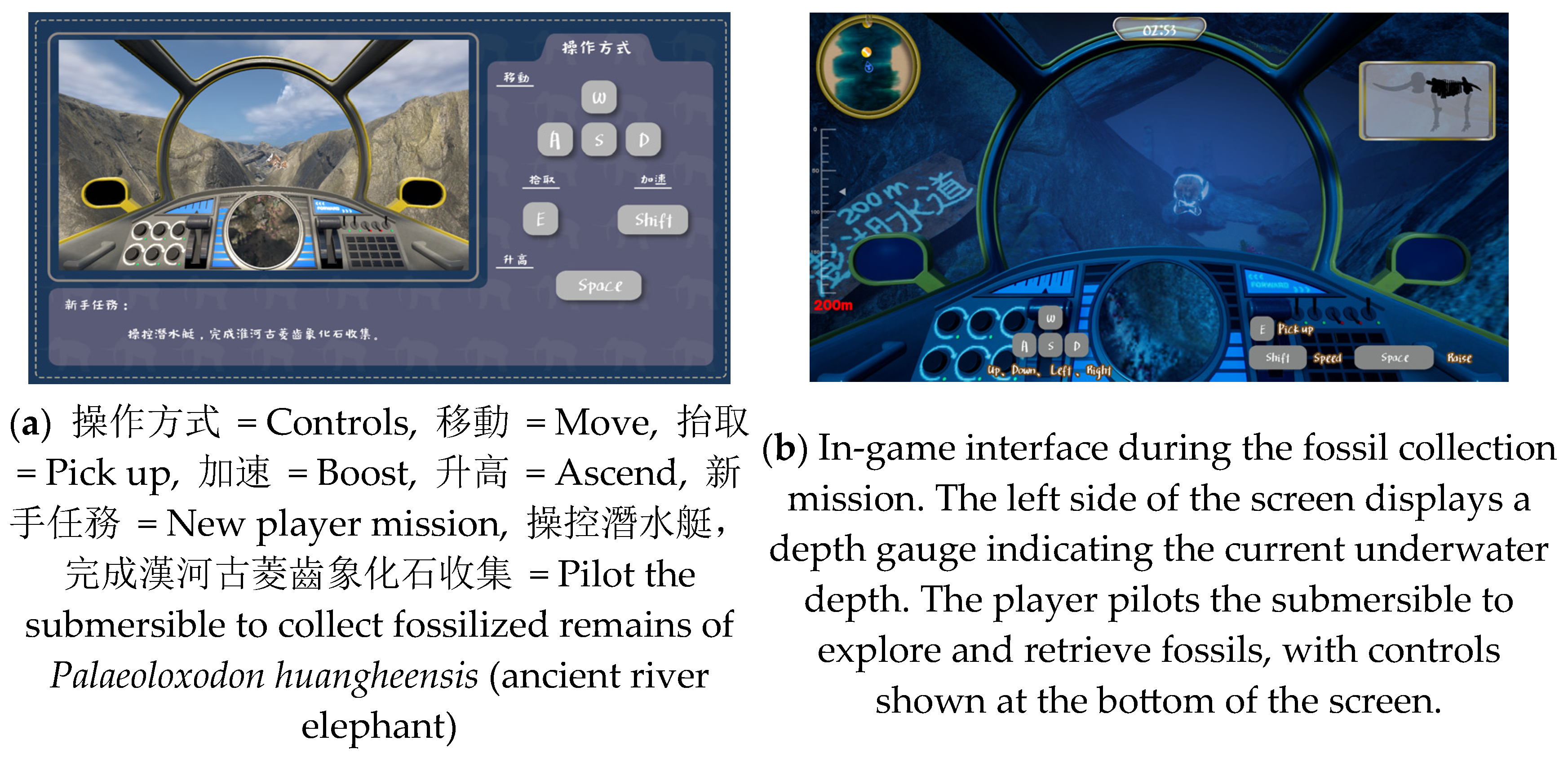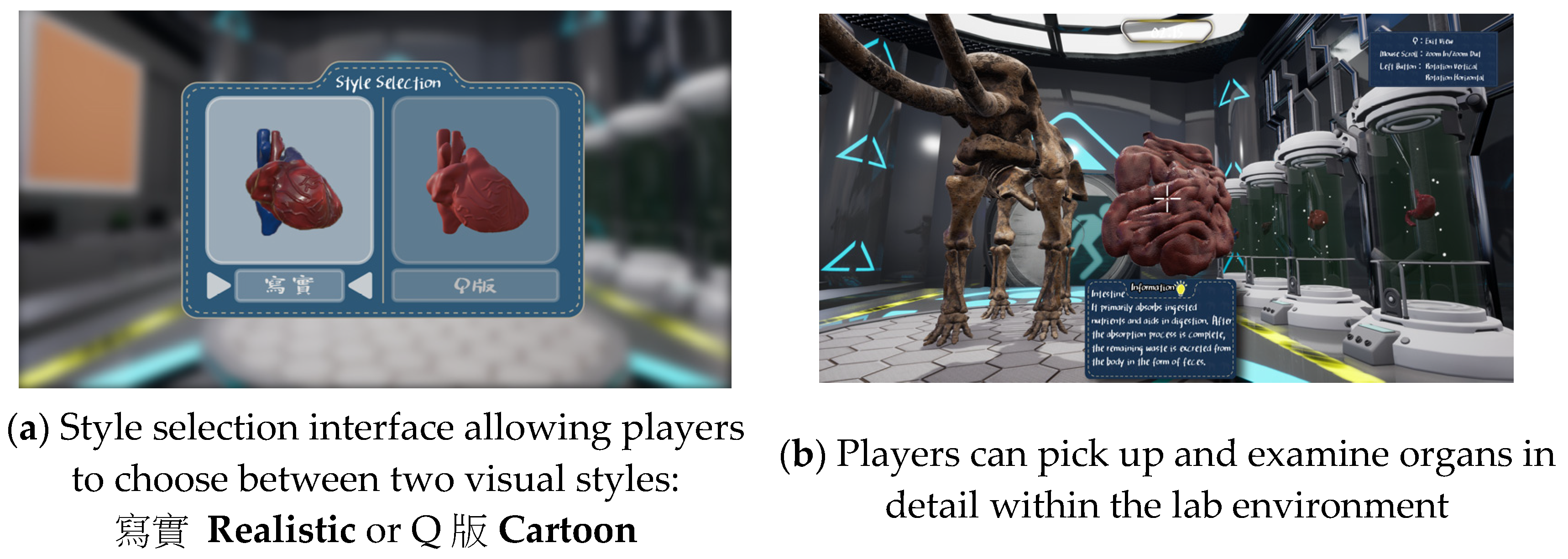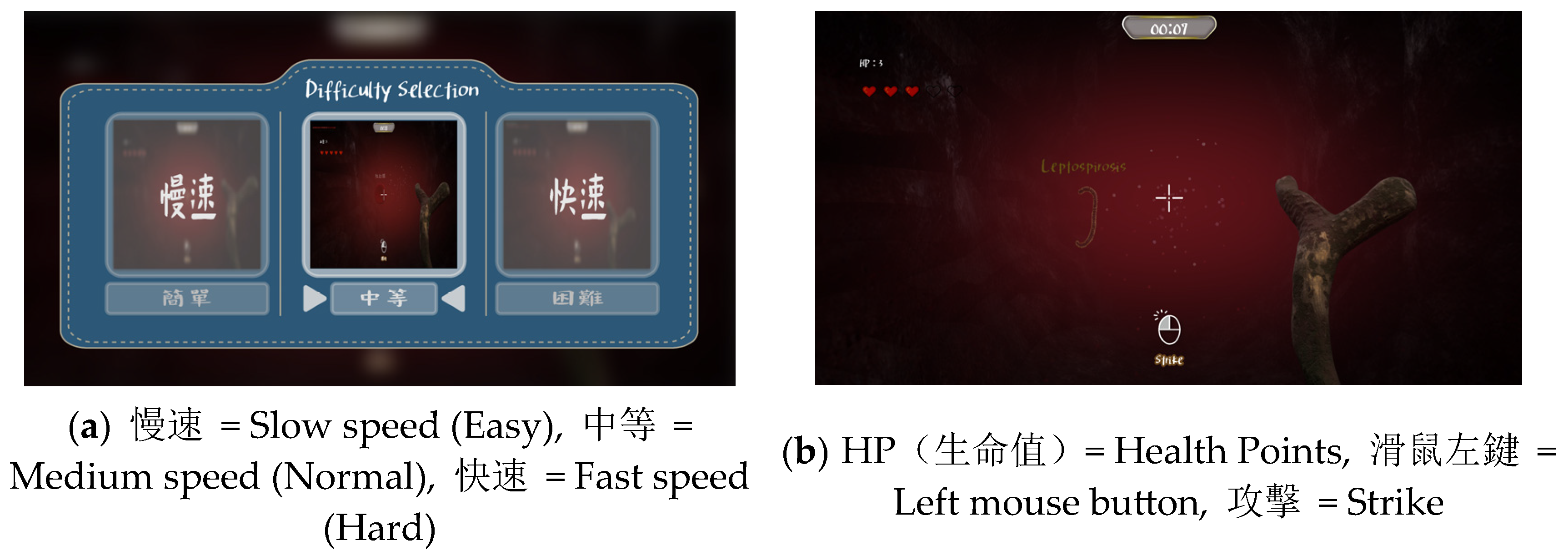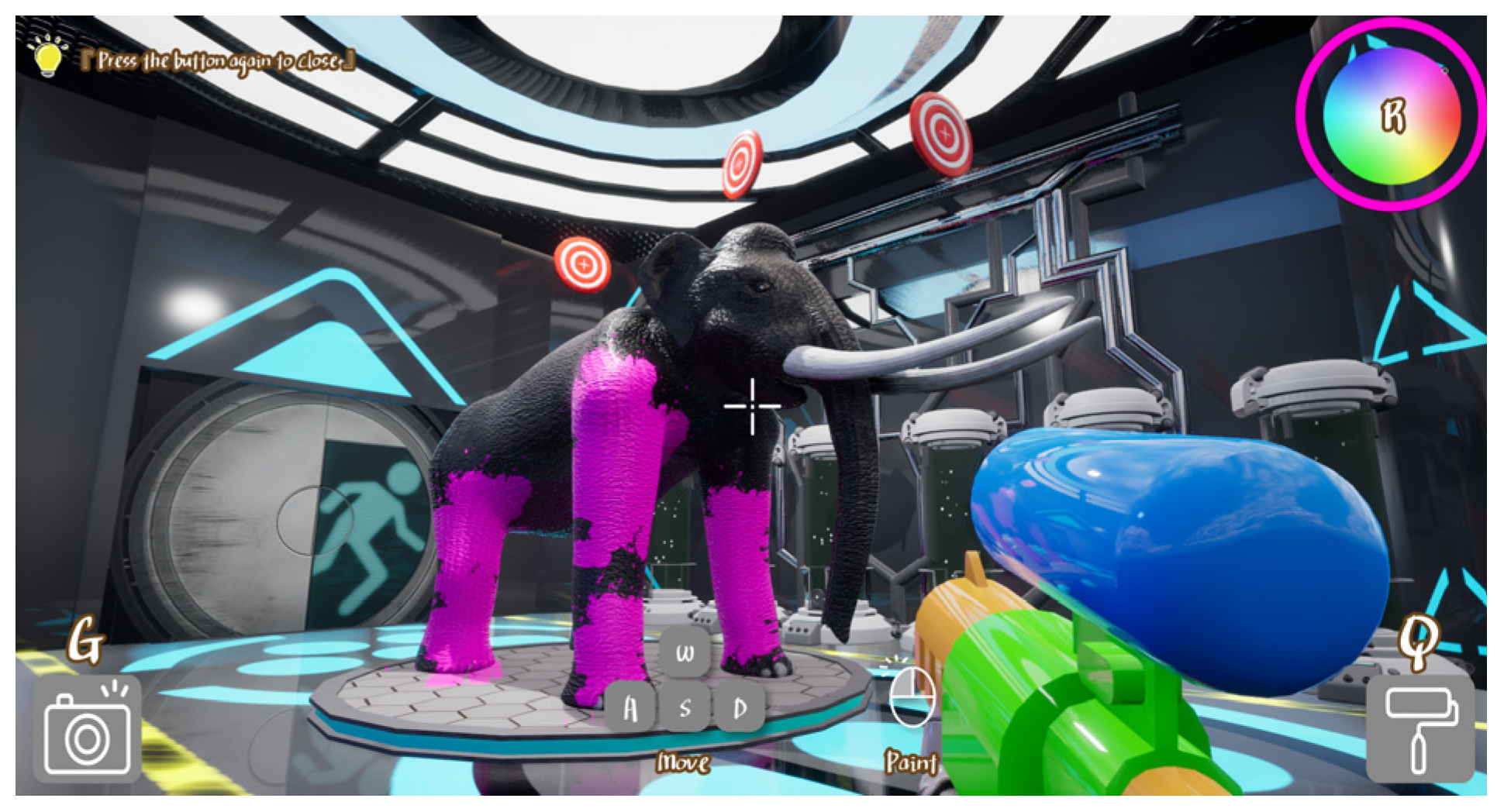Serious Game Design Integrating Design–Play–Experience Framework: Digital Interactive Experience Exploring Ecology of Palaeoloxodon †
Abstract
1. Introduction
2. Related Works
2.1. Palaeoloxodon huaihoensis
2.2. Games Design
2.3. GPS Model
2.4. DPE Framework
3. Materials and Methods
3.1. Game Processes
3.2. Level Design
3.2.1. “See Sea Bones” Level
3.2.2. “Assembling Organs” Level
3.2.3. “Bacterias Cleaner” Level
3.2.4. “Painting Elephant” Level
3.3. Questionnaire Survey
4. Results
5. Conclusions
Author Contributions
Funding
Institutional Review Board Statement
Informed Consent Statement
Data Availability Statement
Conflicts of Interest
Appendix A
- The learning process in the game is more engaging than traditional passive information reception.
- The contextual design of the animation helped me learn about the Palaeoloxodon.
- The real-time feedback in the game helped me understand my performance.
- The controls were easy and straightforward.
- The goal design in each level helped me stay focused.
- The difficulty level of the game was appropriate.
- 7.
- In the “Organ Reconstruction” level, my chosen style was:Stylized Organs □ Realistic Organs □ None (did not play)
- 8.
- The design of my chosen style in the “Organ Reconstruction” level suited my personal preferences.
- 9.
- The coloring process in the “Palaeoloxodon Painting” level enhanced my creativity.
- 10.
- The game interface was aesthetically pleasing.
- 11.
- The cutscenes between levels were smooth and engaging.
- 12.
- The feedback effects (such as click effects, success/failure indicators) were well-executed.
References
- Liu, S.; Xu, X.; Claypool, M. A Survey and Taxonomy of Latency Compensation Techniques for Network Computer Games. ACM Comput. Surv. 2022, 54, 1–34. [Google Scholar] [CrossRef]
- Colombo, S.; Hansson, P.; Nyström, M.B.T. Mining Players’ Experience in Computer Games: Immersion Affects Flow but Not Presence. Comput. Hum. Behav. Rep. 2023, 12, 100334. [Google Scholar] [CrossRef]
- Yannier, N.; Crowley, K.; Do, Y.; Hudson, S.E.; Koedinger, K.R. Intelligent Science Exhibits: Transforming Hands-on Exhibits into Mixed-Reality Learning Experiences. J. Learn. Sci. 2022, 31, 335–368. [Google Scholar] [CrossRef]
- National Museum of Natural Science. Online Museum—Rich Educational Video Resources. Available online: https://www.nmns.edu.tw/ch/learn/online-museum/science-video/ResourceVideo-000085/ (accessed on 13 October 2024).
- Chang, C.H. Fossil Gem of The Penghu Waterway. Ti. Chih. 2023, 42, 47–51. [Google Scholar]
- National Museum of Natural Science. Long Time No See, AKO!—Reintroducing The Ancient Stegodon. Available online: https://www.nmns.edu.tw/ch/learn/museum-education/theme/Theme-000211/ (accessed on 24 October 2024).
- Biswas, D.S.; Chang, C.H.; Tsai, C.H. Land of The Giants: Body Mass Estimates of Palaeoloxodon from the Pleistocene of Taiwan. Quat. Sci. Rev. 2024, 336, 108761. [Google Scholar] [CrossRef]
- Lazareva, M.; Gorovik, A. Analysis of Methods for Developing Educational Computer Games. In Proceedings of the XV International Online Conference “Improving Farming Productivity and Agroecology—Ecosystem Restoration” (IPFA), Dnipro, Ukraine, 5–8 September 2023; Volume 452, pp. 1–8. [Google Scholar]
- Nguyen, V.B. Serious Game Classifications and Models in Higher Education and Serious Training. Ph.D. Thesis, University of Economics, Prague, Czech Republic, 2021. [Google Scholar]
- Masoumi, S.S.; Amini, M.M.; Asgharpour, M.H. Analyzing Behavioral Patterns in the Serious Game ‘Twelve Minutes’: Insights from Iranian YouTubers. In Proceedings of the 6th International Serious Games Symposium, Tehran, Iran, 21–22 December 2023; pp. 1–6. [Google Scholar]
- Seraji, F.; Musavi, O. Does Applying the Principles of Constructivism Learning Add to The Popularity of Serious games? A Systematic Mixed Studies Review. Entertain. Comput. 2023, 47, 100585. [Google Scholar] [CrossRef]
- Caserman, P.; Hoffmann, K.; Müller, P.; Schaub, M.; Straßburg, K.; Wiemeyer, J.; Bruder, R.; Göbel, S. Quality Criteria for Serious games: Serious Part, Game Part, and Balance. JMIR Serious Games 2020, 8, e19037. [Google Scholar] [CrossRef] [PubMed]
- Feng, Z.; Gao, Y.; Zhang, T. Gamification for Visualization Applications in The Construction Industry. In Industry 4.0 for the Built Environment: Methodologies, Technologies and Skills; Bolpagni, M., Gavina, R., Ribeiro, D., Eds.; Springer: New York, NY, USA, 2022; Volume 20, pp. 495–514. [Google Scholar]
- Djaouti, D.; Alvarez, J.; Jessel, J.P. Classifying Serious games: The GPS Model. In Handbook of Research on Improving Learning and Motivation Through Educational Games: Multidisciplinary Approaches; IGI Global: Hershey, PA, USA, 2011; pp. 118–136. [Google Scholar]
- Wibawa, D.A.S.; Setiawan, H.; Girinoto. Anti-Phishing Game Framework Based on Extended Design Play Experience (DPE) Framework as An Educational Media. In Proceedings of the International Workshop on Big Data and Information Security, Depok, Indonesia, 1–3 October 2022; pp. 107–112. [Google Scholar]
- Winn, B.M. The Design, Play, and Experience Framework. In Handbook of Research on Effective Electronic Gaming in Education; IGI Global: Hershey, PA, USA, 2009; pp. 1010–1024. [Google Scholar]
- Hossan, D.; Mansor, Z.D.; Jaharuddin, N.S. Research Population and Sampling in Quantitative Study. Int. J. Bus. Technopreneur. 2023, 13, 209–222. [Google Scholar] [CrossRef]
- Doğan, N.; Yurtçu, M.; Gündeğer, C. The Effect of Option Differences on Psychometric Properties of Items in Likert-Type Scales. Sak. Univ. J. Educ. 2023, 13, 207–237. [Google Scholar] [CrossRef]
- Kankaraš, M.; Capecchi, S. Neither Agree nor Disagree: Use and Misuse of The Neutral Response Category in Likert-Type Scales. METRON 2024, 83, 111–140. [Google Scholar] [CrossRef]
- Schrum, M.; Ghuy, M.; Hedlund-Botti, E.; Natarajan, M.; Johnson, M.; Gombolay, M. Concerning Trends in Likert Scale Usage in Human-Robot Interaction: Towards Improving Best Practices. ACM Trans. Hum.-Robot. Interact. 2023, 12, 1–32. [Google Scholar] [CrossRef]





| Item | Sample (N) | Average Score | SD |
|---|---|---|---|
| Q 1 | 180 | 4.52 | 0.720 |
| Q 2 | 180 | 4.56 | 0.644 |
| Q 3 | 180 | 4.46 | 0.735 |
| Q 4 | 180 | 4.41 | 0.864 |
| Q 5 | 180 | 4.58 | 0.643 |
| Q 6 | 180 | 4.44 | 0.778 |
| Q 7 | 180 | 4.64 | 0.567 |
| Q 8 | 180 | N/A | N/A |
| Q 9 | 164 | 4.38 | 0.785 |
| Q10 | 164 | 4.54 | 0.686 |
| Q11 | 180 | 4.53 | 0.697 |
| Q12 | 180 | 4.47 | 0.743 |
| Q13 | 180 | 4.59 | 0.623 |
Disclaimer/Publisher’s Note: The statements, opinions and data contained in all publications are solely those of the individual author(s) and contributor(s) and not of MDPI and/or the editor(s). MDPI and/or the editor(s) disclaim responsibility for any injury to people or property resulting from any ideas, methods, instructions or products referred to in the content. |
© 2025 by the authors. Licensee MDPI, Basel, Switzerland. This article is an open access article distributed under the terms and conditions of the Creative Commons Attribution (CC BY) license (https://creativecommons.org/licenses/by/4.0/).
Share and Cite
Lu, T.-C.; Chen, Y.-C.; Chang, C.-H. Serious Game Design Integrating Design–Play–Experience Framework: Digital Interactive Experience Exploring Ecology of Palaeoloxodon. Eng. Proc. 2025, 98, 21. https://doi.org/10.3390/engproc2025098021
Lu T-C, Chen Y-C, Chang C-H. Serious Game Design Integrating Design–Play–Experience Framework: Digital Interactive Experience Exploring Ecology of Palaeoloxodon. Engineering Proceedings. 2025; 98(1):21. https://doi.org/10.3390/engproc2025098021
Chicago/Turabian StyleLu, Tzu-Chuen, Yu-Ci Chen, and Chun-Hsiang Chang. 2025. "Serious Game Design Integrating Design–Play–Experience Framework: Digital Interactive Experience Exploring Ecology of Palaeoloxodon" Engineering Proceedings 98, no. 1: 21. https://doi.org/10.3390/engproc2025098021
APA StyleLu, T.-C., Chen, Y.-C., & Chang, C.-H. (2025). Serious Game Design Integrating Design–Play–Experience Framework: Digital Interactive Experience Exploring Ecology of Palaeoloxodon. Engineering Proceedings, 98(1), 21. https://doi.org/10.3390/engproc2025098021







